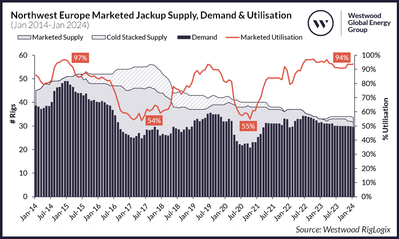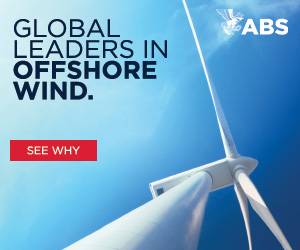Liza Unity sail away.
Photo by Charlie Xia/Copyright SBM Offshore
table of contents
-

Supporting Innovations in Offshore Wind
-

With Utilization Peak Reached in 2023, North Sea Jack-Ups Set for Flat 2024?
Global jack-up marketed utilization has been on an upward trajectory since 2017, reaching its peak of 94% at the end of 2023. However, the outlook for the year ahead looks somewhat flat, though there is still time for new demand.
-
The APAC Offshore Market: Riding the Wave of Success into 2024 and Beyond
2023 was the first year of real recovery for owners in the offshore supply market and yet we have barely skimmed the surface of what’s to come.
-
OSV Owners Reap the Rewards of Data Sharing
A ‘Connected Future’ seminar, organized by Inmarsat in collaboration with Maritime Reporter & Engineering News and moderated by Greg Trauthwein, encapsulated the critical roles technology and data sharing play in enabling more efficient and sustainable workboat operations, and in improving conditions for crew.
-
Floating Production – A growing segment in transition
The specialized deepwater oil & gas and floating offshore wind segments will share many of the same stakeholders and supply chains, competing for increasingly scarce resources.
-
Three Questions: Matt Tremblay, VP, Global Offshore Markets, ABS
The American Bureau of Shipping dominates the global market in the classification of Floating Production. Offshore Engineer recently sat with Matt Tremblay, ABS’ Vice President of Global Offshore Markets, at American Bureau of Shipping HQ in Houston for his insights on market drivers and technical trends in this dynamic market.
-
Floating Production’s Bull Run
Offshore floating energy production is on a growth path, with two important energy production milestones hit in the ‘Golden Triangle’ of Latin America, Africa and the U.S. Gulf in late 2023.
-
Digitalization is Drawing CCS a New Learning Curve
Digital solutions are accelerating the progress required to ensure CCS earns its place in climate change mitigation history.
-
Green(er) Rigs & Stena Drilling
As the offshore oil and gas industry transitions to more sustainable practices, drilling rig operators are faced with demands to implement greenhouse gas (GHG) abatement measures as part of their workload. Being the owner of the first ever drillship that secured DNV’s Abate(P) notation, Scotland-based offshore drilling contractor Stena Drilling discusses everything the company is doing to make its drill-ships ‘greener’.
-
Mocean Energy Aims to Create an Offshore Renewable Microgrid
Garnering power from ocean waves is a generation behind the progress of offshore wind, but Mocean Energy, led by founder and managing director Cameron McNatt, is aiming to help offshore companies power up their offshore and seafloor assets with its Blue Star system. A 10 kW Blue Star prototype now has more than 14 months of operational experience under its belt, and the goal for 2024 is completion of that trial and continuing the path toward commercialization.
-
Gazelle Prepares for a Floating Wind Future
As offshore wind power spreads globally, it’s widely acknowledged that the maturing of floating wind power platforms will exponentially increase the availability of resources, as the majority of wind power lies outside the installation zone of fixed systems. Enter Gazelle Wind Power, which offers a compelling, modular engineered solution and value proposition to the market. Newly minted Gazelle CFO Alvaro Ortega discusses the outlook for Gazelle in the offshore floating wind sector.
-
ROVs – Innovation Enablers
Navigating the depths of efficiency.
-
Enhancing Environmental Accountability in Offshore Operations via Data Analytics
As an industry, the offshore energy sector continues to evolve its approach to reducing environmental impact. Looking beyond the mandatory reporting of scope 1 and 2 carbon emissions, focus is now shifting to scope 3 emissions where many global energy leaders are starting to commit to targets despite reporting not yet being obligatory. But this is a complex, challenging step that requires expert support to achieve. David Cole, Director at KBR Project Solutions, discusses how best to implement a comprehensive system of emissions reporting and analysis across the lifecycle of offshore assets.
-
By the Numbers: Discoveries & Reserves
-
By the numbers: RIGS

